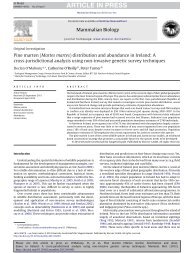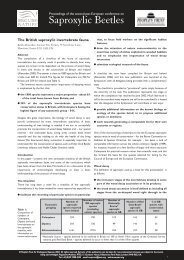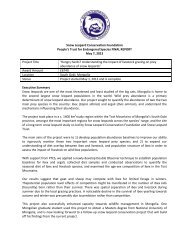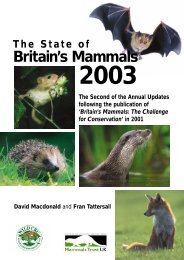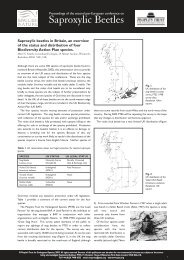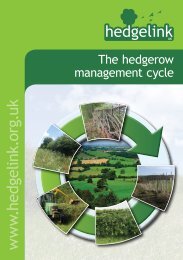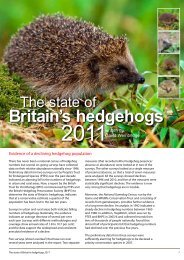The state of Britain's mammals - People's Trust for Endangered ...
The state of Britain's mammals - People's Trust for Endangered ...
The state of Britain's mammals - People's Trust for Endangered ...
Create successful ePaper yourself
Turn your PDF publications into a flip-book with our unique Google optimized e-Paper software.
INTRODUCTION<br />
What is a non-native species?<br />
Non-native animals and plants are those moved<br />
around the globe beyond their native range, either<br />
intentionally, or as an unexpected consequence <strong>of</strong><br />
movement <strong>of</strong> people or products 25 . <strong>The</strong> consequences<br />
<strong>of</strong> such introductions vary from negligible to<br />
devastating. In the UK, 5% <strong>of</strong> all priority species with<br />
Biodiversity Action Plans (BAP) list non-natives as<br />
a threat (9% <strong>for</strong> vertebrates), and non-natives are<br />
identified as a threat to 32% <strong>of</strong> priority habitats.<br />
Most <strong>of</strong> Britain’s non-native <strong>mammals</strong> were brought<br />
here deliberately, giving contemporary conservationists<br />
pause to wonder which <strong>of</strong> their actions will be judged<br />
ludicrous, or perhaps improper, with hindsight.<br />
However, even the Victorian penchant <strong>for</strong> exotics –<br />
which added muntjac, sika and grey squirrels to our<br />
worries – had its gainsayers: in 1866 Krefft cautioned,<br />
'<strong>The</strong> author protests against the wilful introduction <strong>of</strong><br />
alien species without permission <strong>of</strong> competent authority' 26 .<br />
Escapes continue – the red-necked wallabies <strong>of</strong><br />
Derbyshire added marsupials to Britain’s fauna (though<br />
they are now dying out there). Some were deliberate<br />
such as the release <strong>of</strong> 6 000 farmed mink liberated by<br />
animal rights activists from the New Forest in 1998.<br />
Many <strong>of</strong> these returned voluntarily to their cages,<br />
and most <strong>of</strong> the remainder doubtless starved, but<br />
the survivors bolstered the numbers that had already<br />
escaped causing a blight on native species. Overall, as<br />
this report concludes, non-native invasive species <strong>of</strong>ten<br />
damage and always alter native biodiversity, and these<br />
generalisations apply to Britain’s non-native <strong>mammals</strong>.<br />
Invasion terminology<br />
<strong>The</strong> vocabulary <strong>of</strong> biological invasions blurs the<br />
technical and day-to-day usages <strong>of</strong> similar words (e.g.<br />
exotic, imported or alien), and can risk moralistic or<br />
jingoistic nuances 27, 28 . Equally there are no agreed<br />
measurements <strong>of</strong> the level <strong>of</strong> impact, or its type,<br />
other than it should be ‘major’, that an incoming<br />
species must exert on a community in order to be<br />
considered invasive. Only 10% <strong>of</strong> introduced species<br />
become established, and <strong>of</strong> those only 10% become<br />
pests 29 . However, that small percentage is not an<br />
inconsequential number <strong>of</strong> invasive species that can<br />
cause havoc within native ecosystems – the extinction<br />
risk caused by invasives may be second only to that<br />
<strong>of</strong> habitat destruction 30 . Non-native species have<br />
been introduced worldwide, including meadow grass<br />
to Antarctica 31 and some, like the house mouse, are<br />
distributed globally 32 (commensal rodents introduced<br />
to islands are implicated in the extinction <strong>of</strong> at least 11<br />
small mammal species 33 ).<br />
Compared with natural colonizations or<br />
recolonizations that occur on an evolutionary and<br />
geological time scale, invasions are characterised<br />
by their speed. One recently proposed definition<br />
attempts to circumvent geographic boundaries and the<br />
degree <strong>of</strong> impact, by taking a mechanistic approach:<br />
‘A biological invasion consists <strong>of</strong> a species acquiring a<br />
competitive advantage following the disappearance <strong>of</strong><br />
natural obstacles to its proliferation, which allows it to<br />
spread rapidly and to conquer novel areas within recipient<br />
ecosystems in which it becomes a dominant population’ 27 .<br />
This definition does not distinguish between native or<br />
non-native species, but is based purely on ecological<br />
processes in response to a change in (<strong>for</strong> natives) or <strong>of</strong><br />
(<strong>for</strong> non-natives) the environment. For context, native<br />
<strong>mammals</strong> that might be considered invasive (and<br />
variously judged benign or malign by different people),<br />
ins<strong>of</strong>ar as a change in food availability has radically<br />
increased their abundance, include the badgers<br />
<strong>of</strong> agricultural pastures and the foxes <strong>of</strong> suburban<br />
gardens. However, this report focuses only on nonnative<br />
species.<br />
For the purpose <strong>of</strong> this report, in line with the<br />
Convention on Biological Diversity’s 34 definition<br />
adopted by the European Alien Species Gateway 35 and<br />
the Global Invasive Species Database 36 , we use invasive<br />
to mean those species whose arrival was mediated by<br />
humans (non-natives) and that produce undesirable<br />
impacts 37 . We also consider other categories <strong>of</strong> nonnative<br />
<strong>mammals</strong> that, whilst considered substantially<br />
less harmful, certainly alter the natural British<br />
community; some <strong>of</strong> these may have the potential to<br />
become invasive.<br />
When are non-natives part <strong>of</strong> the natural<br />
community?<br />
Some non-native British <strong>mammals</strong> arrived long ago,<br />
but <strong>for</strong> how long must a species be resident be<strong>for</strong>e it<br />
is accepted as part <strong>of</strong> the natural British community?<br />
Technically, ecologists refer to naturalized species<br />
meaning those non-natives that are established in the<br />
wild in self-sustaining and self-perpetuating numbers<br />
without support, and independent, <strong>of</strong> humans 38 .<br />
This ecological meaning is distinctly different to<br />
the colloquial usage that implies the acquisition <strong>of</strong><br />
citizenship. Is the qualifying residency <strong>for</strong> ecological<br />
citizenship measured in years or generations, and<br />
is it affected by the extent to which they are a<br />
nuisance (either to people or to native biodiversity)?<br />
At what point is it no longer appropriate to attempt<br />
a non-natives control just on the grounds <strong>of</strong> its nonnativeness?<br />
Answers to none <strong>of</strong> these questions are<br />
clear from everyday attitudes to Britain’s non-native<br />
<strong>mammals</strong> 25 . Fallow deer, brought to the UK by the<br />
Normans, are commonly treated as native, but lagging<br />
nearly a thousand years behind, muntjac are not. Most<br />
American mink in England probably descend from<br />
ancestors that have bred in the wild here <strong>for</strong> more than<br />
50 generations, and there may have been closer to 150<br />
generations <strong>of</strong> grey squirrels, but there are few calls<br />
to consider either as adopted natural members <strong>of</strong> the<br />
ecological community. <strong>The</strong> Romans brought rabbits to<br />
Britain deliberately (initially held captive in stone-walled<br />
leporaria, <strong>for</strong> the delicacy <strong>of</strong> their embryos – though it<br />
was not until the 12th century that they were free-living<br />
in England) as they did black rats, unwittingly; so both<br />
have been resident <strong>for</strong> at least as long as brown hares<br />
which were also introduced.<br />
Inconsistency and prejudice are rife in media<br />
Laurie Campbell<br />
coverage <strong>of</strong> non-native species – as is muddled<br />
thinking (one example being to consider the cost<br />
<strong>of</strong> eradicating a species as part <strong>of</strong> the evidence that<br />
it is economically damaging). Conservationists too<br />
should be aware that inconsistencies may arise. <strong>The</strong><br />
hatred focused on American mink eating Hebridean<br />
sea birds is relentless, while the protests at killing<br />
hedgehogs that do much the same – also introduced<br />
to the Hebrides – is passionate (see pages 20-21). <strong>The</strong><br />
attitudes expressed about <strong>mammals</strong>, birds and even<br />
fish differ from those applied to various invertebrates.<br />
<strong>The</strong> media, and even some biologists, are much<br />
more inclined to mention the non-native origins <strong>of</strong><br />
some species than others (vide ‘the American tree<br />
rat’), an instance <strong>of</strong> bio-xenophobia partly, but not<br />
wholly, influenced by the nuisance they are perceived<br />
to cause. <strong>The</strong>re is an interesting distinction between<br />
whether that nuisance afflicts human (economic)<br />
wellbeing or native biodiversity 28 . <strong>The</strong> grey squirrel<br />
causes economic damage to <strong>for</strong>estry by bark-stripping,<br />
and severely threatens native red squirrels, through a<br />
combination <strong>of</strong> exploitation competition and disease.<br />
American mink have little economic impact, but have<br />
deva<strong>state</strong>d populations <strong>of</strong> the native water vole and<br />
some birds. Mink have been in the UK <strong>for</strong> almost as<br />
long as grey squirrels (and may even be distributed as<br />
widely, having colonized Scotland as far north as the<br />
Great Glen). However, whereas many millions <strong>of</strong> people<br />
are charmed by the highly visible grey squirrels, almost<br />
nobody speaks up <strong>for</strong> the elusive (but deeply beautiful<br />
and marvellously adapted) mink.<br />
We suggest that the decision to consider a<br />
naturalized non-native species as an ecological citizen<br />
hinges solely on the nature <strong>of</strong> the damage it causes<br />
to native biodiversity. For as long as<br />
that damage is judged intolerably<br />
undesirable then the intruder<br />
remains a pest to biodiversity,<br />
and ef<strong>for</strong>ts to remove it, or<br />
otherwise mitigate its impact,<br />
are justified indefinitely.<br />
<strong>The</strong>re comes a point where<br />
a non-native has been<br />
exerting its influence<br />
on native biodiversity<br />
<strong>for</strong> so long that a new<br />
community has emerged,<br />
American mink (Neovison vison)<br />
In response to demands created by the fashion industry,<br />
mink were imported from northern America to stock<br />
British fur farms in 1929 45 . Following numerous escapes<br />
they had become widely established in the wild across<br />
Britain by the 1970s 46 . Today, they are found from the<br />
south <strong>of</strong> England as far north as Ullapool and the Dornoch<br />
Firth in Scotland and on Harris and Lewis and the Uists<br />
in the Outer Hebrides. Signs found further north on the<br />
mainland may be from transient individuals 47,48 . <strong>The</strong><br />
spread <strong>of</strong> mink in the UK may have been facilitated by the<br />
coincidental, but unrelated, reduction in their potential<br />
native competitors the otter (due to poisoning from<br />
environmental pollution and persecution) and the polecat<br />
(nearly hunted to extinction as vermin). Both polecats<br />
and otters are now increasing in the UK 9 , but there is no<br />
evidence that the presence <strong>of</strong> a healthy otter population<br />
prevents mink from spreading. Although mink signs tend<br />
to decline where otters re-establish 49,50 , mink can coexist<br />
with otters; seemingly by altering their behaviour in<br />
response to the presence <strong>of</strong> their competitors 51,52,53 .<br />
<strong>The</strong> mink’s predatory adaptability has had detrimental<br />
consequences <strong>for</strong> British wildlife, most notably <strong>for</strong> water<br />
voles, and <strong>for</strong> island populations <strong>of</strong> ground-nesting birds 45 .<br />
<strong>The</strong> water vole has suffered a dramatic decline in numbers<br />
in the UK which can be attributed in large part to American<br />
mink, and the presence <strong>of</strong> this species is also considered<br />
inimical to the water voles’ recovery 54 . In the uplands the<br />
spread <strong>of</strong> mink and impact on water voles is facilitated by<br />
the presence <strong>of</strong> rabbits in those prey-poor environments<br />
(giving rise to a pattern <strong>of</strong> apparent competition between<br />
water voles and rabbits 6 ). Experimental studies have<br />
shown it is possible to control mink on short stretches <strong>of</strong><br />
lowland river 55 , and various removal projects have been<br />
undertaken <strong>for</strong> water vole protection (East Yorkshire;<br />
Cheshire; North Wales; Norfolk, Suffolk and Essex; Upper<br />
Thames; Somerset and Dorset 56 ). Mink can be efficiently<br />
trapped (and humanely dispatched) using live traps<br />
on floating rafts designed by the Game and Wildlife<br />
Conservation <strong>Trust</strong>. In the Cairngorms National Park and<br />
northeast Scotland, major mink control ef<strong>for</strong>ts assisted by<br />
volunteers 57 have resulted in an area already exceeding<br />
7 000 km 2 being mink free. American mink have not spread<br />
to the far north <strong>of</strong> Scotland, and genetic analysis has<br />
shown differentiation between populations in west and<br />
north-east Scotland suggesting that the Cairngorms<br />
<strong>for</strong>m a barrier to dispersal, but that the Great Glen<br />
area acts as a corridor from west to east Scotland 58 .<br />
So, following methods used in the West Country by<br />
the Environment Agency and the British Association<br />
<strong>for</strong> Shooting and Conservation, a cordon sanitaire<br />
designed to halt their spread further north is<br />
underway. This involves monitoring and trapping<br />
along rivers and the coastline from Ullapool to the<br />
Dornoch Firth 47,57 ).<br />
American mink may be declining in their native<br />
range in Canada, and suggested explanations<br />
include interbreeding with feral captive mink<br />
(perhaps poorly adapted <strong>for</strong> survival in the wild)<br />
and over-hunting 59 .<br />
NBN Gateway copyright © Crown Copyright. All rights reserved NERC 100017897 2004<br />
6 <strong>The</strong> <strong>state</strong> <strong>of</strong> Britain’s <strong>mammals</strong> a focus on invasive species <strong>The</strong> <strong>state</strong> <strong>of</strong> Britain’s <strong>mammals</strong> a focus on invasive species 7





